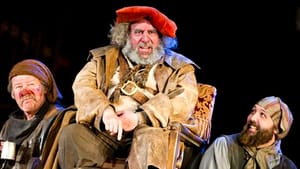Stay in the Loop
BSR publishes on a weekly schedule, with an email newsletter every Wednesday and Thursday morning. There’s no paywall, and subscribing is always free.
Henry, we hardly knew ye
Royal Shakespeare’s ‘Henry IV’

Why care about Shakespeare’s histories? So many hours, so many characters, so many details, so long ago.
The Bard’s motive, of course, was to engender sympathy for Queen Elizabeth’s ancestors. In Richard II, both parts of Henry IV, and Henry V, Shakespeare dramatized the way Elizabeth’s forebears came to power and to maturity. But in the process, Shakespeare created a plethora of diverse and colorful characters and involved them in personal rivalries, military adventures, and high-jinks comedy. You needn’t be a history buff or a Brit to enjoy this diversity.
Henry IV (Part I) reveals a major flaw in its apparent hero: Prince Hal (later Henry V) proclaims that his convivial behavior at the Boar’s Head tavern is just a disguise — that he’s pretending to be a friend of common folk so he can astound everyone, later on, with a reformation. How admirable is lying to his friends and deceiving his family?
But Shakespeare was demonstrating that manipulation is a necessary tool for leaders — especially for a young man burdened with a seriously judgmental father in Henry IV.
Shakespeare presents a contrast in his play’s rulers: stern Henry IV; the unpredictable Hal; the hot-tempered Hotspur; the self-centered Worcester who led the rebellion against King Richard II; and the mystical Welsh leader Glendower.
Falstaff’s poses
A special charm in these plays is Shakespeare’s use of different languages and accents, such as the Welsh and Irish words that are not understood by the English characters — not to mention the bartender’s coarse speech, which is incomprehensible even to Englishmen of the upper classes. Here we see Harry’s rare ability to bond with these disparate types and, literately, speak their language.
The center of tavern life is the fat and elderly Sir John Falstaff, who poses as a liar, a braggart, a glutton, and a coward, more to amuse others than to gratify himself.
Part I ends with a dramatic battle in which Hal squelches the Percy family’s rebellion by killing Harry Hotspur. Then, when we come to Part II, I empathize with the skeptics. The plot rehashes much of what we saw in Part I. For that reason, some companies have combined the two parts into a single play (Orson Welles united them in his film Chimes at Midnight). King Henry IV is still disappointed with his son. Another rebellion is organized, but we don’t witness any battles. Rather, Prince Hal’s younger brother subdues the enemy by trickery.
Sick country
Despite this flaw, Part II carries an entrancing melancholy. There’s much talk of aging and death — “death...is certain to all; all shall die” — and Falstaff speaks of the simple folk he recruits for battle as "food for powder; they'll fill a pit.” The buffoonish Falstaff wistfully reunites with his boyhood friend Shallow and experiences a touching and affectionate moment with a homely, aging prostitute. The king and his enemies alike repeatedly wonder what will become of their sick country and yearn for renewal.
The drama ends with Henry IV’s death and his successor’s devastating rejection of the bewildered Falstaff (portrayed throughout both plays with a gentle and affecting sweetness by Antony Sher). The new king — Henry V, known as Hal— coldly declares that he can no longer associate with such people. which is most affecting.
Alex Hassell makes a handsome, charismatic Prince Hal, and Jasper Britton is a pathetic King Henry IV. (Rarely does a Shakespearean title character have so little to do and so few attractive aspects.)
The Royal Shakespeare uses a thrust stage with almost no scenery, relying on imaginative lighting as it shifts between Eastcheap and Westminster.
Both plays, as well as the Royal Shakespeare’s other productions, are being shown in HD at the expanded Bryn Mawr Film Institute, a venerable Main Line film mecca that now offers new and comfortable state-of-the-art screening rooms.
To view a video clip, click here:
http://stratford-upon-avon-theatre.blogspot.com/2014/03/rsc-henry-iv-part-i-review-stratford.html
What, When, Where
Henry IV (Parts I and II). By William Shakespeare; Gregory Doran directed. Through September 6, 2014 in repertory at Royal Shakespeare Theatre, Stratford-upon-Avon, England. www.rsc.org.uk. Also broadcast live in HD to cinemas, including Bryn Mawr Film Institute, 824 West Lancaster Ave., Bryn Mawr, PA. 610-527-9898 or www.brynmawrfilm.org.
Sign up for our newsletter
All of the week's new articles, all in one place. Sign up for the free weekly BSR newsletters, and don't miss a conversation.
 Steve Cohen
Steve Cohen